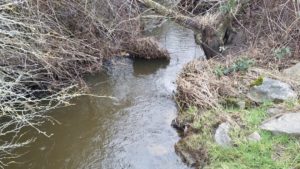With oil trains running daily to Whatcom refineries since 2013, it was only a matter of time.
On December 22nd, a unit train carrying approximately 3.5 million gallons of crude oil, bound for the Phillips 66 Ferndale Refinery at Cherry Point, derailed in Whatcom County along Portal Way in Custer. Ten tank cars fell off the tracks, and oil spilling from several punctured cars ignited into a fire that burned from late morning to evening.
Since 2012, when crude oil began to be shipped regularly with this type of train, 1.5 miles long with over 100 tank cars, numerous other incidents resulted in explosions, massive damages and loss of life. Thankfully that day in Custer, emergency responders arrived at the scene swiftly to contain the spill and control the burn.
The environmental damages, though relatively minimal, may have significant impacts to public health and fisheries and some key questions remain unanswered about the spill and clean-up (more on this below).
This destructive incident — merely a stone’s throw away from houses, an elementary school, a church and several businesses — could easily have become a blazing catastrophe, if not for a combination of sheer luck preceded by years of hard work in preparation for the foreseeable risks and hazards of an oil train calamity.
Amid increased oil-by-rail, our community pushed for oil train safety and emergency response plans
From 2013 to 2016, we saw 11 oil train derailments across the continent, including one headed for the Salish Sea shoreline that derailed and burned in June 2016 along the Columbia River in Mosier, Oregon.
RE Sources has advocated for years to enact laws — such as the Oil Transportation Safety Act of 2015 in Washington State — that would reduce the likelihood of oil train derailments and improve inter-agency emergency response planning. We appealed Skagit County’s initial approval of an oil-by-rail terminal, and fought the proposal for two years until the Shell Refinery cancelled the plans. We co-founded the Stand Up to Oil coalition, organized with allies across the region working to stop oil-by-rail proposals in Vancouver, WA and Gray’s Harbor. We continue pushing against corporate retaliation and resistance from lawmakers to stronger safety rules, oversight and accountability for the oil industry.
These efforts have likely prevented more calamitous incidents from harming communities and made emergency responders better coordinated, prepared, and more effective at limiting the extent of damages that occurred in Custer. But as long as oil-by-rail unit trains run through Washington, no regulation could eliminate the likelihood of a derailment occurring somewhere, nor the possibility of an explosion.
Time for action on the Cherry Point Amendments
Now, Whatcom County Council is poised to enact a monumental law that will restrict the two oil refineries at Cherry Point from increasing capacity for oil-by-rail, place stronger conditions on expansions of existing industries, outright prohibit new fossil fuel shipping terminals, and bolster the environmental review process for future industrial projects. After five years of public process for these policies, we expect the Council to vote on this ordinance by the start of Spring.
Stay tuned for updates on the Cherry Point Amendments and other imminent legislation to be introduced, held for public hearings, and voted on.
Concerned about residual oil and toxic fire suppressants used near salmon-bearing streams and well water, our scientists visited the site

Eleanor Hines (North Sound Baykeeper & Lead Scientist) and Kirsten McDade (Pollution Prevention Specialist) visited the derailment site to see what the aftermath looked like for themselves.
The agencies involved in cleaning up the area said there was “no widespread contamination” the day after the incident. We would like to know how they came to that conclusion and if there are data gaps that still need to be addressed. Our scientists were still concerned about residual oil, as well as the use of specialized fire suppressant foams containing PFAS — an emerging contaminant that Washington is beginning to regulate more due to its toxicity, persistence in the environment, and long-lasting impacts.
Eleanor and Kirsten saw berms set up to control stormwater flow, and much contaminated soil appeared to have already been removed. There was still significant construction underway as the site continues to be cleaned up. They also reported there are several salmon-bearing streams nearby, including California Creek and its tributaries.
Our scientists are also concerned for the residents of Custer nearby who use well water, as PFAS have caused a number of health issues in other places. Eleanor and Kirsten continue to follow up with the Department of Ecology and Department of Health to track the testing and its locations, with the goal of ensuring residents’ drinking water is safe and any damage to the environment is properly addressed.
